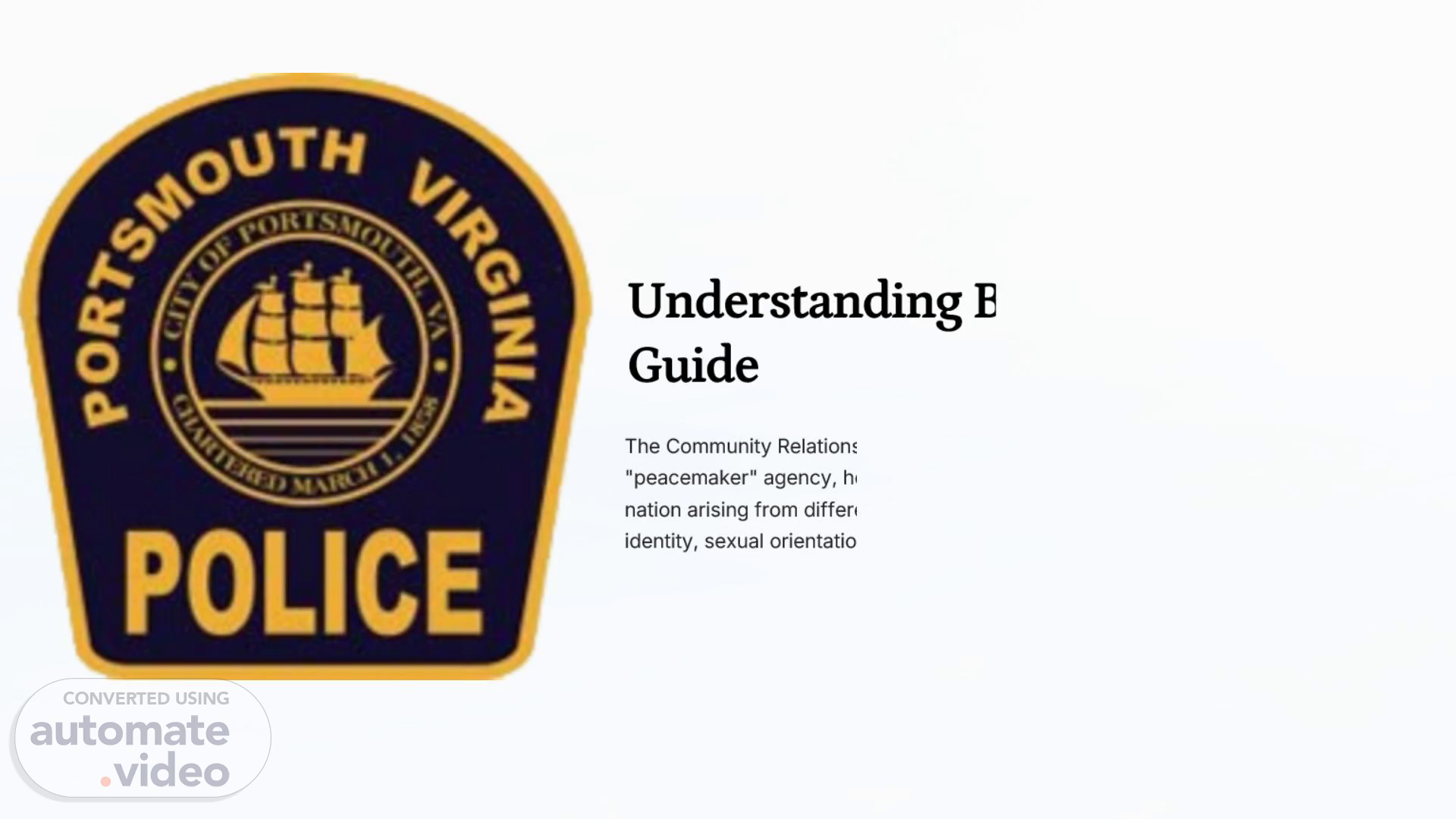Scene 1 (0s)
OUTH POLICE. Understanding Bias: A Resource Guide.
Scene 2 (16s)
O. The Challenge: Bias vs. Cultural Competency. Understanding the Difference.
Scene 3 (39s)
The Science of Bias. Bias is a human trait resulting from our tendency and need to classify individuals into categories as we strive to quickly process information and make sense of the world. To a large extent, these processes occur below the level of consciousness..
Scene 4 (1m 9s)
Stereotypes vs. Attitudes. Stereotypes. The brain sorting new people into easily recognizable groups. For example, "elderly people" or "people who went to the same school that I attended." This is a neutral cognitive process..
Scene 5 (1m 29s)
Two Types of Bias. Explicit Bias. The traditional conceptualization of bias. Individuals are aware of their prejudices and attitudes toward certain groups. Positive or negative preferences for a particular group are conscious. Overt racism and racist comments are examples of explicit biases..
Scene 6 (1m 54s)
Implicit Bias in Policing. Implicit bias can be just as problematic as explicit bias because both may produce discriminatory behavior. With implicit bias, the individual may be unaware that biases, rather than the facts of a situation, are driving their decision-making..
Scene 7 (2m 22s)
Good News: Bias Can Be Reduced. Although everyone has implicit biases, research shows that implicit biases can be reduced through the very process of discussing them and recognizing them for what they are. Once recognized, implicit biases can be reduced or "managed," and individuals can control the likelihood that these biases will affect their behavior..
Scene 8 (2m 47s)
The Policing Paradox. Critical Insight: Psychological research has revealed that an officer's day-to-day work may actually contribute to the development of negative stereotypes..
Scene 9 (3m 12s)
Cultural Competency: A Broader Concept. Developing cultural competency is a relatively new priority in the field of policing, described as a broader concept rather than merely achieving organizational diversity. It refers to the ability of all department personnel to work effectively with individuals from a variety of backgrounds..
Scene 10 (3m 39s)
Levels of Cultural Competency. Cultural competency can be considered in terms of phases or levels, with each successive level representing more knowledge, understanding, and value of differences, and greater awareness of one's own attitudes, perceptions, and worldviews..
Scene 11 (4m 2s)
alaw. Why Cultural Competency Matters. Since police officers encounter individuals from diverse groups on a daily basis, it is important for them to have the necessary cultural competencies to provide them with the knowledge, understanding, and self-awareness needed to best perform their jobs..
Scene 12 (4m 24s)
Building Cultural Competence. Developing cultural competence in law enforcement requires police agencies to take comprehensive action across multiple areas:.
Scene 13 (4m 49s)
illilll. Cultural Competency vs. Stereotyping. The Protection.
Scene 14 (5m 7s)
Types of Bias CRS Addresses. Race, Color, National Origin, and Ethnicity.
Scene 15 (5m 36s)
Religious Bias: A Critical Example. Cultural Misunderstanding: A female Muslim may avoid eye contact with a male officer. An officer might consider this a sign of deceit or evasion, but Muslim culture dictates this as a sign of modesty..
Scene 16 (5m 58s)
Disability Awareness in Policing. Persons with disabilities are protected under the Americans with Disabilities Act (ADA). Police often interact with individuals with disabilities, so awareness is critical..
Scene 17 (6m 22s)
ONLINE. Project Implicit: Measuring Hidden Biases.
Scene 18 (6m 44s)
Understanding IAT Results. Important Consideration: IATs should be used as an educational tool to develop awareness of implicit preferences and stereotypes, not as a tool for making judgments, such as whether to hire a person..
Scene 19 (7m 9s)
Five Evidence-Based Strategies to Reduce Bias. This section presents five evidence-based techniques regarded as some of the most effective strategies for short- and long-term reduction of implicit bias. These strategies are summarized from a 12-week longitudinal study demonstrating long-term reduction of implicit biases..
Scene 20 (7m 33s)
Strategy 1: Stereotype Replacement. Stereotype replacement involves replacing automatic stereotypical responses with new, automatic, non-stereotypical responses..
Scene 21 (7m 57s)
Strategy 2: Counter-Stereotypic Imaging. Counter-stereotypic imaging requires creating an opposite image of a stereotype in your mind. This can be done by examining general ideas, specific famous people, or specific non-famous people you know personally..
Scene 22 (8m 22s)
Strategy 3: Individuation. Individuation is the process of giving individuality to persons in a group, helping prevent making biased inferences about individuals based on gender, race, sexual orientation, etc. This technique involves obtaining information about individual members of a group instead of generalizing..
Scene 23 (8m 48s)
alam a— home I Lorem ipsu adipiscing incididunt ut enim ad exercitation' commodo reprehenderi dolore eu occaecat cug qui officia de ala.
Scene 24 (9m 18s)
Strategy 5: Increased Opportunities for Contact. This strategy is also used as a central tenet of community policing. Seek out opportunities to engage with stigmatized groups in a positive manner. Create positive interactions for both parties..
Scene 25 (9m 45s)
Bringing It All Together. So… where do we go from here?.
Scene 26 (10m 23s)
Cultural Competency: More Than “Diversity”. Now, let’s separate bias from cultural competency. While bias often operates automatically, cultural competency is about cultivating intentional skills..
Scene 27 (11m 8s)
Your Challenge. We can’t simply delete bias from our minds. However, we can actively manage its influence. Here are five practical tools you can start implementing today to consciously reduce bias:.
Scene 28 (11m 51s)
The Path Forward. As officers, you encounter challenging situations daily. If we’re not careful, the constant exposure to negativity can subtly lead to ingrained stereotypes about entire neighborhoods or groups..
Scene 29 (12m 31s)
oßTSo,. Training Resources & Next Steps. While many police agencies have developed internal trainings to increase cultural competency, few have strategies in place to discuss and counter implicit biases. Two national training programs are available:.
